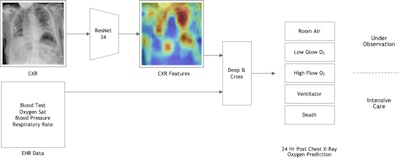
A deep-learning algorithm called CORISK can predict if a patient with COVID-19 symptoms will need supplemental oxygen. CORISK was developed using a federated-learning initiative involving 20 hospitals worldwide, performs well, and is generalizable, according to an announcement Monday at the Nvidia GPU Technology Conference (GTC).
The federated learning project -- called EMR CXR AI Model (EXAM) -- was led by researchers Nvidia and Massachusetts General Brigham Hospital and involved an algorithm initially developed by Dr. Quanzhen Li, PhD, at the institution to help clinicians more effectively manage COVID-19 hospitalizations. Called CORISK, the algorithm utilizes information from chest x-rays and patient data from the electronic health record to arrive at its predictions for supplemental oxygen in the next 24 hours.
To improve performance and to make the algorithm more generalizable to other hospitals, the Nvidia and Massachusetts General Brigham researchers utilized the company's Clara Federated Learning Framework to implement a federated-learning program for CORISK. Over 20 days, 20 institutions trained a local model using their chest x-rays and patient vital and lab values.
The global deep neural network was hosted on a separate server; each participating hospital received a copy of the model to train on its own data, which was stored on a secure, in-house server, according to Nvidia. After being trained on the local data, a subset of the model weights was then shared back with the global model.
The final algorithm yielded an area under the curve of 0.94 for predicting the level of supplemental oxygen needed by incoming COVID-19 patients, according to the company.
The participating sites included the following:
- Children's National Hospital in Washington, DC
- NIHR Cambridge Biomedical Research Center in Cambridge, U.K.
- Self-Defense Forces Central Hospital in Tokyo
- National Taiwan University MeDA Lab and MAHC and Taiwan National Health Insurance Administration
- Chulalongkorn University in Thailand
- Diagnosticos da America SA in Brazil
- University of California, San Francisco
- Veterans Affairs San Diego
- University of Toronto
- U.S. National Institutes of Health in Bethesda, MD
- University of Wisconsin-Madison School of Medicine and Public Health
- Memorial Sloan Kettering Cancer Center in New York City
- Mount Sinai Health System in New York City
"Every single site that participated got an improved benefit -- no matter their dataset -- by participating in [the federated learning project] and being able to adopt the global model," said Kimberly Powell, vice president of healthcare at Nvidia.
 Workflow for COVID-19 oxygen prediction AI algorithm. Image courtesy of Nvidia.
Workflow for COVID-19 oxygen prediction AI algorithm. Image courtesy of Nvidia.Powell said the model will be released as part of Clara on the company's Nvidia GPU Cloud (NGC) software hub in the coming weeks.
In other news from GTC, Nvidia has announced a partnership with GlaxoSmithKline (GSK). The pharmaceutical firm recently launched an AI group in London that will integrate computing platforms for imaging, genomics, and AI into the drug and vaccine discovery process, according to Nvidia.
In addition, Nvidia said it will be deploying a supercomputer in the U.K. that will be dedicated to supporting AI research in healthcare. The supercomputer, called Cambridge-1, will be used by GSK, AstraZeneca, Guy's and St Thomas' NHS Foundation Trust, King's College London, and Oxford Nanopore.
Cambridge-1 will be part of Nvidia's planned AI Center of Excellence in Cambridge, U.K., which aims to provide a collaboration hub for AI researchers, scientists, and startups in the U.K.




















